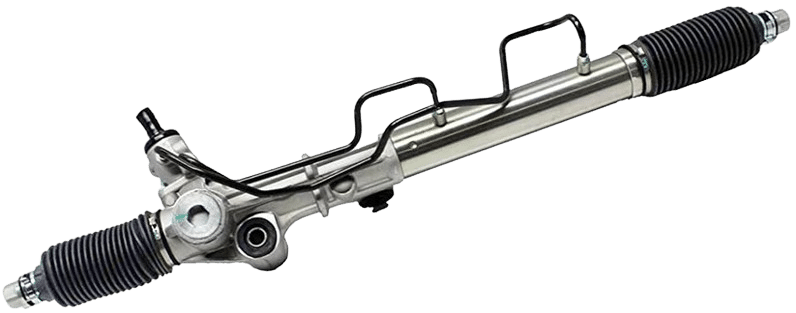Introduction:
Toyota and Lexus vehicles are famous for their reliability. You may even joke around with your Jeep buddies about never getting death wobble. Unfortunately, every vehicle has its achilles heel. For Toyota and Lexus, it is steering rack failure. I bet you won’t be laughing when you tell them your steering rack needs to be replaced.
If you’re noticing steering issues or leaks under your vehicle, it might be time to pay attention. Let’s dive into why this happens, the symptoms to watch for, and why fixing it might cost an arm and a leg.

Why Do Toyota and Lexus Steering Racks Fail?
- Wear and Tear
The steering rack is a hard working component translating your steering wheel’s motion into precise directional changes for the wheels. Over time, seals wear out and internal components degrade. - Fluid Neglect
Power steering fluid isn’t just there for show—it lubricates and cools the system. Old or contaminated fluid can degrade internal components leading to leaks and failure. If you haven’t checked your fluid since your truck’s warranty expired, now’s the time. - Off-road and Hard Use
Taking your vehicle off-road or, heck, even some of Colorado's roads can put extra strain and accelerate wear on the steering rack. - Age-related Failures
For older Toyota and Lexus models, age alone is a factor. That engine still ticks like a swiss watch but something's got to give and I don’t think we need to explain why getting old sucks do we?
Symptoms of a Failing Steering Rack
- Leaking Power Steering Fluid
If you spot a puddle under your vehicle near the engine, there's a chance it's the rack. Typically pooling up in the steering rack bushings and weeping out. Your steering boots may just look shiny. - Stiff or Unresponsive Steering
Excess play in the steering wheel? Maybe a little stiff to turn? Intermittent or not, it could be a sign. - Clunking Noises
Hear clunks or knocks when you turn the wheel? That’s likely internal wear or loose components in the steering rack. It could also be the bushings that secure the rack to the chassis. Worn bushings allow the rack to slam back and forth before the rack even moves the tires. - Uneven Tire Wear
- A failing rack can mess with your alignment, causing tires to wear unevenly. It’s a pricey side effect of neglecting steering issues.
Why Are Steering Rack Repairs So Expensive?
- Labor-Intensive Replacement
The steering rack can be buried in the engine bay, sometimes requiring hours of labor just to access. With standard labor hours ranging from at least 3 hours to over 10 hours depending on the model. But don’t worry - we have some tricks and written processes that cut times down considerably. Like removing the oil filter housing and doing an oil change at the same time. Sounds silly, but it saves us (or I should say you) a few hours on 4Runners. - High Parts Costs
A new OEM steering rack doesn’t come cheap and while there are cheaper alternatives. We've tested them enough to know better. Even a Remanufactured unit is enough to scoff at. - Alignment Required After Replacement
Once the new rack is installed, an alignment is mandatory to prevent tire wear or an upside down steering wheel. Newer models have steering angle sensors that need reset as well.
The Problem With Remanufactured Units
While we do use them, we like to go over some warnings first.
- Inconsistent Quality: Many remanufactured racks use subpar seals and components, leading to early failures. Because we are a company that stands behind our repairs. We still honor our 3 year nationwide warranty. The question we ask is: how often do you want to have your car in the shop? Not to mention the risk of failure at the worst time possible.
- Offroad: Offroad use can put extra strain on parts and we've tested first hand that remanufactured units just don’t hold up as long as a new one.
- Bushings: Trust us! We learned the hard way. But we're happy to learn and be able to educate you from experience. Imagine you put a “new” remanufactured steering rack in a customer's Tacoma and suddenly it pulls to one side when braking. Lots of head scratching later we realized the manufacturer had pressed the bushings in the wrong way allowing more movement on one side. This is the kind of eye for detail we typically see. It's like rolling the dice and hoping for the best.
- Rattle Can Tune Up: Hate to say it but even Toyota and Lexus branded racks that are remanufactured have given us a rack with old dry rotted torn bushings that were just painted over. But hey, if it's shiny, it's brand new right?
- Wait a minute! You said you use remans after all this? After all the trouble you've seen? How can you recommend something like this?
- Oftentimes we swap the bushings out for something upgraded like a poly urethane kit from superpro.
- We inspect every part before installing to the best of our ability before installing.
- We stand behind our work and do what's right. 3 year / 36k mile on labor and parts.
- The bottom line is everyone has a budget. We try to adapt to offer the best service we can to fit someone's needs.
Recommended Options When You Experience Steering Rack Failure
- Good: A remanufactured unit from Toyota or Lexus
- Better: A beautiful new rack and pinion from Toyota or Lexus.
- Best: A beautiful new rack and pinion from Toyota or Lexus with SuperPro bushings
Conclusion:
Steering rack and pinion failure is a headache no Toyota or Lexus owner wants to face, but it’s a common issue with age and wear. By staying on top of maintenance and choosing quality replacement parts, you can avoid repeat failures and keep your SUV or truck driving as smoothly as the day you bought it.

